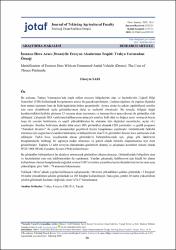| dc.contributor.author | Sarı, Hüseyin | |
| dc.date.accessioned | 2023-04-20T08:02:31Z | |
| dc.date.available | 2023-04-20T08:02:31Z | |
| dc.date.issued | 2022 | |
| dc.identifier.issn | 1302-7050 | |
| dc.identifier.issn | 2146-5894 | |
| dc.identifier.uri | https://doi.org/10.33462/jotaf.892105 | |
| dc.identifier.uri | https://hdl.handle.net/20.500.11776/10976 | |
| dc.description.abstract | The present study was conducted to determine the areas and volumes of erosion zones in Thrace peninsula using geographical information systems (GIS). Measurements made with remote sensing both save time and prevent excess workforce. In addition, it is less costly than satellite images that can be purchased for areas where drones can be shot. For this purpose, 13 erosion sites with different environmental characteristics were examined and images were obtained with an unmanned aerial vehicle (UAV) in the study area. To calibrate the UAV data, the boundaries were determined using nature-friendly white paint. Then, all measurements (lengths, angles, etc.) of these areas were calculated from various altitudes. Volume of the determined areas then processed using GIS software and a graphic program named Autodesk Inventor. All of the UAV tasks were taken under suitable weather condition in order to avoid any difference in the images. Furher, the UAV images to be combined were obtained under similar weather conditions to ensure that factors such as light and shadow do not cause any deviation in the calculations and create visual differences. Images were taken from a total of 13 erosion areas and WGS 1984 (World Geodetic System 1984) was used as the coordinate system in the present study. Orthomosaic images of these areas were created by combining the images. In addition to the areas and volumes of the regions in the images, calibration analyzes were also made. Using a small area for calibration in the study increased the accuracy of area measurement rate above 90%, while this rate was found between 60 - 78% in volume measurement depending on the flight altitude. 12 photos were used in the image taken from a height of 100 meters and 103 from a height of 10 meters in the calibration from approximately 100 m(2). Accordingly, the volumetric accuracy rate was found to be 78.57% in the image taken from a height of 10 meters from the ground. | en_US |
| dc.language.iso | tur | en_US |
| dc.publisher | Univ Namik Kemal | en_US |
| dc.identifier.doi | 10.33462/jotaf.892105 | |
| dc.rights | info:eu-repo/semantics/openAccess | en_US |
| dc.subject | Thrace | en_US |
| dc.subject | Erosion | en_US |
| dc.subject | Gis | en_US |
| dc.subject | Uav | en_US |
| dc.subject | Soil | en_US |
| dc.subject | Soil-Erosion | en_US |
| dc.subject | Basin | en_US |
| dc.title | Identification of Erosion Sites With an Unmanned Aerial Vehicle (Drone): The Case of Thrace Peninsula | en_US |
| dc.type | article | en_US |
| dc.relation.ispartof | Journal of Tekirdag Agriculture Faculty-Tekirdag Ziraat Fakultesi Dergisi | en_US |
| dc.department | Fakülteler, Ziraat Fakültesi, Toprak Bilimi ve Bitki Besleme Bölümü | en_US |
| dc.identifier.volume | 19 | en_US |
| dc.identifier.issue | 1 | en_US |
| dc.identifier.startpage | 70 | en_US |
| dc.identifier.endpage | 79 | en_US |
| dc.institutionauthor | Sarı, Hüseyin | |
| dc.relation.publicationcategory | Makale - Uluslararası Hakemli Dergi - Kurum Öğretim Elemanı | en_US |
| dc.authorscopusid | 57204239210 | |
| dc.identifier.wos | WOS:000795484100007 | en_US |
| dc.identifier.scopus | 2-s2.0-85131383783 | en_US |



















